USE OF A PRESSURE-SENSITIVE ADHESIVE TO FACILITATE THE TRANSFER OF A SEVERELY TENTED PAINTINGGIANFRANCO POCOBENE, & IAN HODKINSON
5 PATTERNS OF DAMAGE IN THE SAWYER PAINTINGAn examination of the tenting patterns formed in this painting reveals how the forces were generated in the painting as it reacted to the water. The most acute canvas shrinkage occurred near the perimeter of the painting (fig. 1), with the exception of the top left corner, which may not have been totally saturated. One possible explanation for this pattern is that the canvas was first wetted at the edges from contact with the stretcher bars. The soaked stretcher may also have kept the edges of the canvas wet for a longer period softening the glue size at the edges more than in other areas. A second possibility is that the greatest shrinkage forces were formed along the perimeter. This observation accords with research by Hedley (1975), which indicates that the stresses generated at the corners and edges of a painting are greater than those in the center. Tenting was generally less severe toward the center. Of interest, however, was the predominantly vertical orientation of the tenting. One or more structural differences between the warp and weft yarns—such as thread count, yarn diameter, degree of twist, and perhaps sizing at the time of weaving—may have caused the warp yarns to move closer together, resulting in more crimping of the weft yarns and greater shrinkage of the canvas in the horizontal direction. One area in the center of the painting above the sitter's left shoulder (fig. 1), which had received a blow at an earlier time, exhibited severe tented cleavage. Areas immediately surrounding this dent, however, were less affected. It would appear from this feature that prestressed and cracked paint layers are more prone to be lifted out of plane. At the right tacking margin, where paint film damage was most severe, scallop-shaped patterns of tented cleavage were also observed (fig. 3). Remarkably, a tent emanated from each tack, then curved back in a series of tents to its neighboring tack point. Since the tents are formed perpendicular to the principal direction of the compression forces generated by the shrinking fabric, a reconstruction of the direction of shrinkage forces in the painting is possible (fig. 3). This pattern resulted from differences in the magnitude and direction of stresses at the tack points and between them. Between the tack points, the predominant forces were generated perpendicular to the painting edge. These stresses were released as tents formed parallel to the edge. Just above the tack points, however, the movement of the canvas toward the center was restricted by the tacks. Here, the shrinkage occurred
Surprisingly, areas of overpaint—which, ironically, represent restorations probably connected with earlier water damage—remained unaffected by the water. The restorations in oil covered numerous voids along the left edge and more extensive losses along the bottom edge. Perhaps earlier loss of glue size layer or heavy consolidation in the previous restoration prevented canvas shrinkage and paint detachment. |
